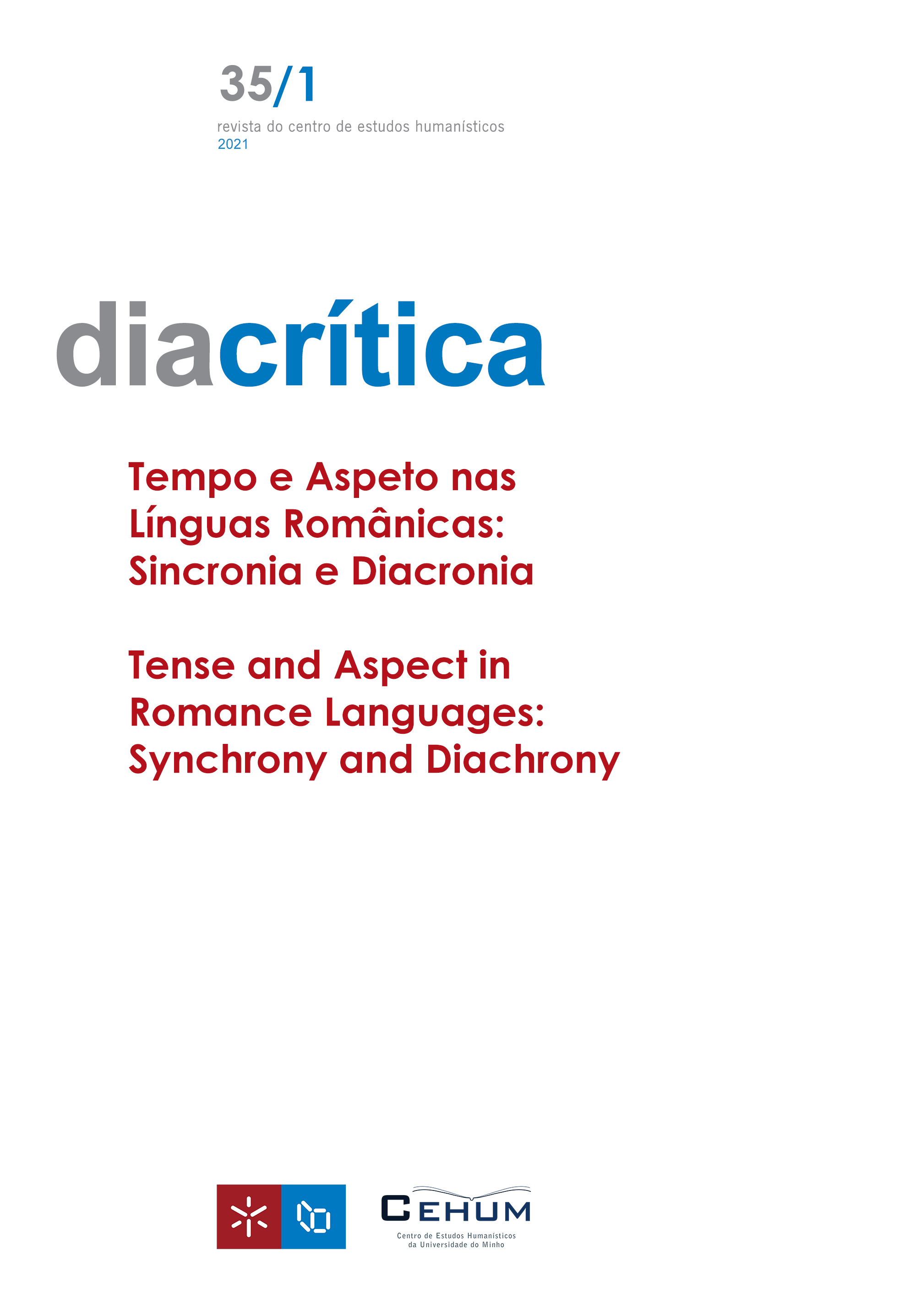Realization of durativity features in 'estar + gerund' periphrasis in Santiago de Chile’s Spanish and Madrid Spanish
DOI:
https://doi.org/10.21814/diacritica.5115Keywords:
Aspect, Durativity, Estar gerund, Santiago de Child's Spanish, Madrid SpanishAbstract
In this article, we investigated the presence of the durativity feature in sentences with “estar+gerund” periphrasis in Santiago de Chile’s and Madrid’s Spanish. Our hypothesis is that, in order to form durative meanings in the researched varieties, the “estar+gerund” periphrasis is associated only with sentences constructed with (i) durative adverbial modifiers; (ii) subjects of collective, continuous, agentive and non-agentive type; and (iii) activity and accomplishment verbs. To test this hypothesis, we analyzed five interviews from the PRESEEA corpus of Santiago city and five interviews from the same corpus of Madrid city. The results showed similar sentential patterns in the researched varieties in order to form durative meanings with “estar+gerund” periphrasis. Thus, sentences with durative aspectual meanings were formed, preferably, by punctual adverbial modifiers; by agentive, individual and discontinuous subjects; and by activity verbs.
References
aspecto léxico. In I. Bosque & V. Demonte (Eds.), Gramática descriptiva de la lengua española (Vol. 2, pp. 2979–3035). Madrid: Real Academia Española/Ed. Espasa Calpe.
Giorgi, A., & Pianesi, F. (1997). Tense and aspect: From semantics to morphosyntax. New York: Oxford University Press.
King, L., & Suñer, M. (1980). The Meaning of the Progressive in Spanish and Portuguese. Bilingual Review, 7(3), 222–238.
Moreno Fernández, F. (2005). Project for the Sociolinguistic Study of Spanish from Spain and America (PRESEEA) – A Corpus with a Grammar and Discourse Bias. In T. Takagaki, S. Zaima, Y. Tsuruga, F. Moreno Fernández & Y. Kawaguchi (Eds.), Corpus-Based Approaches to Sentence Structures (pp. 265–288). Amsterdam: John Benjamins. DOI: https://doi.org/10.1075/ubli.2.16mor
Pollock, J. (1989). Verb movement, Universal Grammar, and the structure of IP. Linguistic Inquiry, 20, 365–424.
PRESEEA. (2014). Corpus del Proyecto para el estudio sociolingüístico del español de España y de América. Alcalá de Henares: Universidad de Alcalá. Consultado em http://preseea.linguas.net
Rothstein, S. (2004). Structuring events: A study in the semantics of aspect. Oxford: Blackwell. DOI: https://doi.org/10.1002/9780470759127
Sebold, M., & Maggessy, A. (2020). Traços de iteratividade e suas realizações em línguas próximas. Domínios de Lingu@gem, 14(2), 510–541. https://doi.org/10.14393/DL42-v14n2a2020-7 DOI: https://doi.org/10.14393/DL42-v14n2a2020-7
Sigurðsson, H. (2005). Meaningful silence, meaningless sounds. In P. Pica (Ed.), Linguistic variation yearbook. Amsterdam: John Benjamins. DOI: https://doi.org/10.1075/livy.4.07sig
Smith, C. (1991). The Parameter of aspect. Dordrecht: Kluwer Academics Publishers. DOI: https://doi.org/10.1007/978-94-015-7911-7
Soto, G., & Castro, C. (2010). Una caracterización funcional de estar + gerundio como aspecto de fase: Progresividad, dinamicidad y lectura de caso (token). Revista de Lingüística Teórica y Aplicada, 48(2), 93–113. https://doi.org/10.4067/S0718-48832010000200005 DOI: https://doi.org/10.4067/S0718-48832010000200005
Swart, H. (1998). Aspect shift and coercion. Natural Language & Linguistic Theory, 16(2), 347–385. https://doi.org/10.1023/A:1005916004600 DOI: https://doi.org/10.1023/A:1005916004600
Vendler, Z. (1967). Linguistics in philosophy. Ithaca: Cornell University Press. DOI: https://doi.org/10.7591/9781501743726
Verkuyl, H. (1993). A theory of aspectuality - The interaction between temporal and atemporal structure. Cambridge: Cambridge University Press. DOI: https://doi.org/10.1017/CBO9780511597848
Yllera, A. (1999). Las perífrasis verbales de gerundio y participio. In I. Bosque & V. Demonte (Eds.), Gramática descriptiva de la lengua española (Vol. 2, pp. 3391–3442). Madrid: Real Academia Española/Ed. Espasa Calpe.
Downloads
Published
How to Cite
Issue
Section
License
Copyright (c) 2023 Maria Mercedes Riveiro Quintans Sebold, Thaís da Silveira Neves Araújo

This work is licensed under a Creative Commons Attribution-NonCommercial 4.0 International License.










